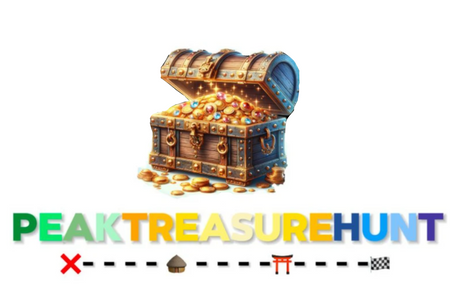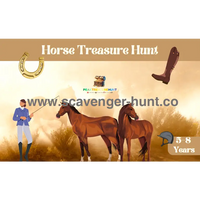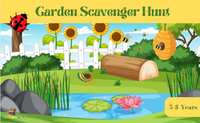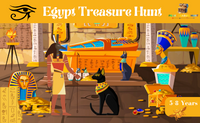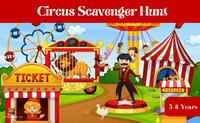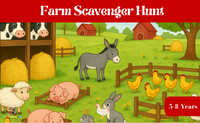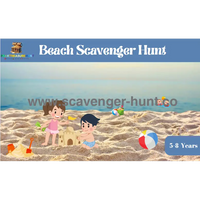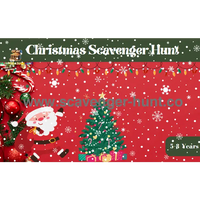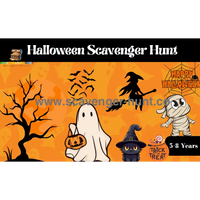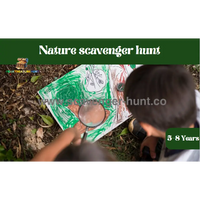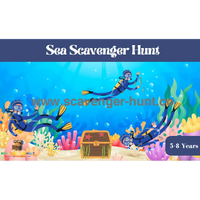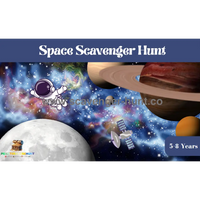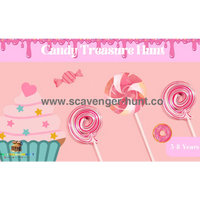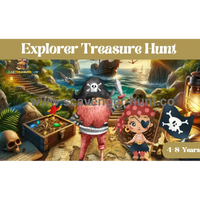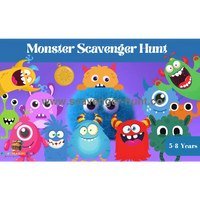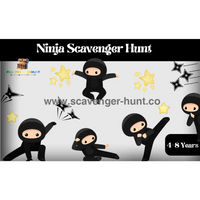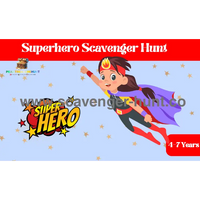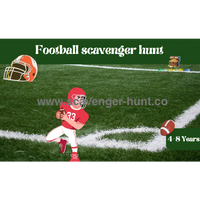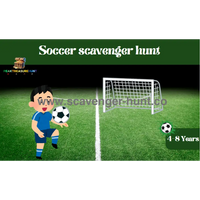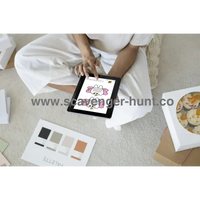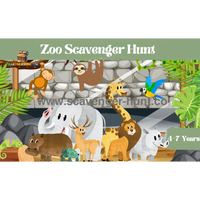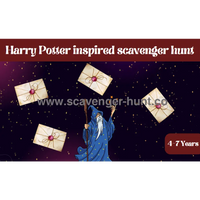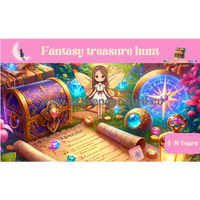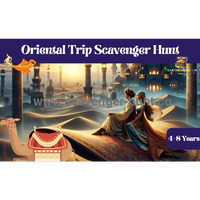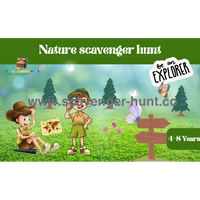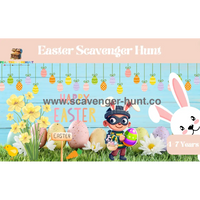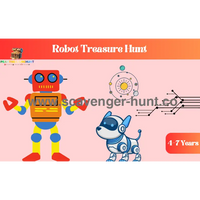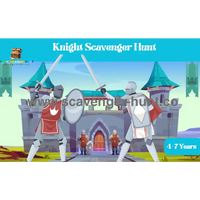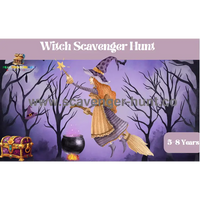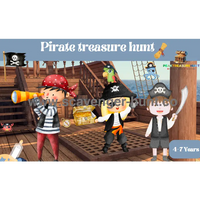🥳🎁Treasure Hunt Children's Birthday Party: A Complete Guide
Hosting a treasure hunt for a children's birthday party is an exciting way to create lasting memories and provide a fun, interactive experience for kids. This blog will guide you through planning and executing a memorable treasure hunt that will delight the birthday child and their friends.
Planning the Treasure Hunt
Choosing a Theme
Selecting a theme for your treasure hunt is more than just picking a fun concept; it’s about setting the stage for a memorable adventure that captivates the imagination of the children. A well-chosen theme can transform a simple game into an epic quest, sparking excitement and engagement from start to finish. Here’s how to choose and develop a theme for your treasure hunt:
1. Brainstorm Ideas: Start by thinking about the interests of the birthday child and their friends. Do they love pirates, superheroes, or fairy tales? Consider their favorite books, movies, or TV shows for inspiration. Popular themes for a treasure hunt include:
-
Pirates: Children become swashbuckling pirates on a quest for hidden treasure. Create a pirate map, use pirate speak, and set up a “ship” or treasure island.
-
Ancient Egypt: Children explore the mysteries of the pyramids and solve riddles related to Egyptian mythology and archaeology. Incorporate hieroglyphics, mummies, and pharaohs.
-
Jungle Adventure: Kids embark on a thrilling journey through a jungle filled with exotic animals and hidden treasures. Use animal prints, jungle sounds, and tropical decorations.
-
Fairy Tales: Children step into a world of magical creatures and enchanted lands. Themes can include characters like fairies, knights, and dragons.
2. Design the Adventure: The theme will guide the design of your treasure hunt, from the clues and decorations to the costumes and activities. For example, if you choose a pirate theme, you might design clues as old pirate maps, use phrases like “Ahoy Matey,” and have a treasure chest filled with gold coins and pirate-themed toys.
3. Create Immersive Experiences: Go beyond just the clues. Immerse the children in the theme with:
-
Decorations: Set the scene with theme-appropriate decorations. For pirates, you might use skull and crossbones flags, treasure maps, and wooden barrels. For a jungle theme, you could use green streamers for vines, stuffed animals, and jungle-themed music.
-
Costumes: Encourage kids to dress up according to the theme. Provide simple costumes or accessories like pirate hats, explorer vests, or fairy wings.
-
Activities: Plan games and challenges that fit the theme. A pirate treasure hunt might include “walk the plank” challenges, while a jungle adventure could involve animal-themed obstacle courses.
Setting the Location
Choosing the right location for your treasure hunt is crucial for ensuring that the adventure runs smoothly and is enjoyable for all participants. Here’s a comprehensive approach to selecting and preparing your treasure hunt location:
1. Decide on Indoor or Outdoor: The location you choose will depend on your theme, the weather, and the space available. Each option has its advantages:
-
Outdoor Locations: Parks, backyards, or garden areas offer ample space and natural elements that can enhance the treasure hunt experience. They are ideal for large-scale hunts with diverse hiding spots and physical challenges.
-
Indoor Locations: Indoor spaces like different rooms in your house or a community center can be perfect for smaller groups or in case of bad weather. They allow for creative setups and themed decorations in a controlled environment.
2. Prepare the Space: Once you’ve chosen the location, make sure it’s ready for the treasure hunt:
-
Safety: Ensure the area is free from hazards like sharp objects, toxic plants, or unstable ground. For outdoor hunts, check for potential dangers like uneven terrain or insects.
-
Suitability: Consider the size of the area and the number of participants. Make sure there is enough space for the children to move around and explore without getting lost or overcrowded.
-
Accessibility: Ensure the location is accessible for all children, including those with disabilities. Provide easy access to the hunt area and make sure paths are clear and safe.
3. Set Up the Hunt: Arrange the treasure hunt elements in the location:
-
Clue Placement: Hide clues in strategic locations that fit the theme. For an outdoor adventure, you might hide clues under rocks, in tree hollows, or at park benches. For indoors, you can place clues under furniture, inside books, or behind pictures.
-
Decorations: Add thematic decorations to enhance the experience. Use banners, props, and thematic items to make the location feel like part of the adventure.
-
Activity Stations: Set up activity stations or challenges along the hunt route if your theme includes them. For example, you might have a “puzzle station” for pirate-themed puzzles or a “magic spell station” for a fairy tale theme.
Preparing the Treasure
Creating the treasure and presenting it at the end of the hunt is the grand finale of your adventure. Here’s how to prepare the treasure and make it special:
1. Selecting the Treasure: Choose items that will excite the children and fit the theme. Popular choices include:
-
Small Toys: Action figures, puzzles, or craft kits that align with the theme.
-
Candy and Treats: Themed candies or snacks like chocolate coins for pirates or gummy animals for a jungle adventure.
-
Stickers and Temporary Tattoos: Fun, themed stickers or tattoos that kids can use after the hunt.
-
Themed Items: Items related to the treasure hunt theme, such as pirate eyepatches, explorer badges, or fairy wands.
2. Creating the Treasure Chest: The treasure chest should look as exciting and authentic as possible:
-
Design: Decorate a box or container to resemble a treasure chest. Use materials like gold foil, treasure maps, or fabric to give it an old-fashioned look.
-
Fill It Up: Arrange the treasure items inside the chest. Consider adding some fake gold coins, jewel-like stones, or “ancient” scrolls to make the chest look full of riches.
-
Final Presentation: Place the treasure chest in a dramatic location where the children will find it at the end of the hunt. Make it the centerpiece of the grand finale and capture their excitement with photos.
3. Adding Personal Touches: Personalize the treasure chest and its contents to make the event special for the birthday child:
-
Personalized Items: Include a special item for the birthday child, like a custom name tag or a special toy.
-
Celebratory Elements: Add a congratulatory note or a “Congratulations!” banner inside the chest to celebrate the children’s success.
By thoughtfully choosing a theme, preparing the location, and creating an exciting treasure chest, you can ensure that your treasure hunt birthday party is a fantastic adventure that children will remember for years to come.


Creating the Clues
Designing Clues
Crafting clues for a treasure hunt is an exciting and creative process that can greatly enhance the fun and engagement of the event. The right clues will not only fit the theme but also challenge and entertain the children. Here’s how to design effective clues for your treasure hunt:
1. Tailor Clues to the Age Group
Younger Children (Ages 3-6):
-
Simple and Direct: Use straightforward clues and simple instructions that are easy for young children to understand. Think of clues like “Look under the big rock” or “Find the next clue near the tree.”
-
Visual Aids: Incorporate pictures or symbols into the clues. For example, use a drawing of a tree or a sun to represent the location of the next clue.
-
Rhyme Time: Rhyming clues can be both fun and easier for young kids to follow. For example: “To find your clue, you don’t need to roam, just look where the flowers call home.”
Older Children (Ages 7 and Up):
-
Complex and Challenging: Create clues that require a bit more thought. Use riddles, word puzzles, or simple codes to make the hunt more engaging.
-
Maps and Codes: Older kids can handle more advanced clues like treasure maps with symbols or coded messages. For example, you could use a map with X marking the spot or create a code that they need to decipher.
2. Align Clues with the Theme
Pirates:
-
Treasure Maps: Draw a map with clues marked as Xs or landmarks. Example clue: “Sail past the tall tree, and you’ll find the clue where the leaves fall.”
Jungle Adventure:
-
Animal Tracks: Use animal footprints to guide the children. Example clue: “Follow the paw prints to the next clue hiding under the leaves.”
Ancient Egypt:
-
Hieroglyphics: Create simple hieroglyphics that spell out clues. Example clue: “Translate these symbols to find your prize: [symbol for tree] [symbol for sun].”
Fairy Tales:
-
Story-Based Clues: Frame clues as part of a fairy tale adventure. Example clue: “The giant’s castle holds your next clue. Look behind the door where the fairy dust flew.”
3. Design Engaging Clues
Make each clue fun and interactive. Instead of just giving the next location, involve a small task or challenge:
-
Puzzle Piece: The clue could be a piece of a larger puzzle that forms a map or picture.
-
Mini-Challenge: Incorporate simple tasks like a mini obstacle course, a short quiz related to the theme, or finding an item like a hidden object or a small toy.
Mapping the Hunt
Creating a map or a series of clues that guide the children from one location to another is a key element of the treasure hunt. Here’s how to effectively map out the treasure hunt:
1. Plan the Route
Determine the Path:
-
Sequential Flow: Arrange the clues in a logical order, so each clue leads to the next. Make sure the path is clear and manageable for the children.
-
Design a Route: Sketch out where each clue will be hidden. If you’re using a map, draw it with clear, easy-to-follow lines and landmarks.
Example Layout:
-
Starting Point: A central location where the children receive the first clue.
-
Clue Stations: Different spots where each subsequent clue is hidden.
-
Final Destination: The location of the treasure chest or final prize.
2. Create Clear and Understandable Clues
Write Clear Instructions:
-
Simple Language: Use straightforward and age-appropriate language.
-
Direct Guidance: Make sure clues provide clear instructions without too much ambiguity. For example, “Look under the bench next to the big tree” is easier than “Find your clue somewhere near a place you sit.”
Example:
-
Clue 1: “To start your quest, go to where the birds like to rest.”
-
Clue 2: “Your next clue is hidden where you might play and where your shoes stay.”
3. Make It Interactive
Include Small Tasks:
-
Fun Activities: Add small games or challenges at each clue location. For example, they could solve a riddle, perform a small task, or complete a mini obstacle.
Example:
-
Task: “To get your next clue, you must hop on one foot ten times.”
Testing the Clues
Testing the clues before the actual event is essential to ensure everything works smoothly. Here’s how to effectively test your treasure hunt setup:
1. Run Through the Hunt
Test the Clues:
-
Solve the Clues: Go through the entire treasure hunt yourself or with a helper. Ensure that the clues make sense, lead to the correct locations, and are at the right difficulty level.
-
Check for Errors: Look for any mistakes or confusing elements in the clues or their placements. Adjust as needed to make the clues clearer or more challenging.
Example:
-
Test Run: If a clue leads to a “tree,” make sure it’s clear which tree you mean, and that the clue is actually hidden where you intended.
2. Evaluate the Hunt Experience
Timing:
-
Check Duration: Ensure the entire hunt takes an appropriate amount of time for the age group you’re targeting. Adjust the number of clues or the complexity based on how long it takes you to complete the hunt.
Example:
-
Adjustments: If the test run takes too long or too short, adjust the number of clues or add more tasks.
3. Adjust Difficulty
Level of Challenge:
-
Difficulty Balance: Ensure that the clues are neither too easy nor too hard. They should challenge the children but still be achievable.
Example:
-
Adjusting Clues: If a clue is too easy, consider adding a step, like solving a puzzle. If too hard, simplify the instructions or provide clearer hints.
By carefully designing age-appropriate clues, mapping out a fun and engaging route, and thoroughly testing your treasure hunt, you can ensure that your event is both exciting and enjoyable for all the children involved.
Organizing the Event
Organizing the
treasure hunt for a
children’s birthday party involves several key steps to ensure the event runs smoothly and is enjoyable for everyone involved. Here’s a comprehensive guide to help you plan and execute a successful treasure hunt.
Inviting Guests
Sending out invitations sets the stage for the treasure hunt and helps you prepare for the number of participants. Here’s how to do it effectively:
1. Choose a Theme for the Invitations
Match the Theme:
- Design invitations that reflect the treasure hunt’s theme. For example, if you’re having a pirate-themed hunt, you might create invitations that look like old treasure maps or “Wanted” posters with the birthday child as the “captain.”
Design Ideas:
-
Pirate: Use aged paper, pirate flags, and treasure maps. Wording could include phrases like “Ahoy Mateys! Join us for a treasure hunt adventure!”
-
Jungle Adventure: Feature jungle animals, leaves, and explorer gear. Use phrases like “Join us on a wild jungle quest for hidden treasure!”
2. Include Important Details
Essential Information:
-
Date and Time: Clearly state when the treasure hunt will begin and end.
-
Location: Provide the exact location of the party, whether it’s at your house, a park, or another venue. Include specific directions if needed.
-
Special Instructions: Let guests know if there are any special requirements, such as costumes related to the theme or items to bring, like a water bottle or sunblock.
-
RSVP Information: Include a way for guests to RSVP so you can plan for the number of children and prepare enough materials.
Example Invitation:
-
Pirate Theme: “Ahoy! Join us for [Child’s Name]’s 7th Birthday Party! Set sail for a pirate treasure hunt adventure on [Date] at [Time]. Meet us at [Location] for fun, games, and treasure! Dress as your favorite pirate and get ready for a swashbuckling good time! Please RSVP by [RSVP Date].”
Setting Up
On the day of the party, preparation is key to ensuring the treasure hunt goes off without a hitch. Here’s how to set up the event:
1. Prepare the Clues and Treasure
Place Clues:
-
Hide the Clues: Arrange each clue in its designated spot according to your plan. Make sure that they are hidden in a way that is challenging but not frustrating for the children. For example, a clue under a rock should be placed in a spot that’s accessible but not immediately obvious.
Set Up the Treasure:
-
Final Destination: Position the treasure chest or final prize in a special location where the children will find it at the end of the hunt. Decorate it to make it look exciting and visually appealing.
Example Setup:
-
Pirate Theme: Set up “X marks the spot” locations, with treasure maps leading to the final prize.
-
Jungle Adventure: Create “jungle paths” with decorations like vines and animal cutouts leading to the treasure.
2. Prepare the Venue
Decorate:
-
Thematic Decorations: Set up decorations that reflect the theme and enhance the atmosphere. Hang themed banners, place props around the venue, and create a festive environment.
-
Activity Stations: If you have any activity stations or mini-games as part of the treasure hunt, set them up in advance. Ensure that all necessary materials are ready and in place.
Example Decorations:
-
Fairy Tale Theme: Decorate with castles, enchanted forests, and fairy lights.
-
Ancient Egypt: Use pyramids, hieroglyphics, and Egyptian artifacts.
3. Set Up for the Event
Prepare Supplies:
-
Materials: Gather all the materials you’ll need for the treasure hunt, such as clue cards, treasure chest, and any props or tools for the activities.
Example Supplies:
-
Clue Cards: Print or write out all the clues on cards.
-
Treasure Chest: Ensure it is filled with goodies and ready to be revealed.
-
Props: Gather any additional props for thematic activities or challenges.
Explaining the Rules
Once all the preparations are complete, it’s time to gather the children and explain the rules of the treasure hunt. This step is crucial for ensuring that the event is fun and runs smoothly.
1. Gather the Children
Group Introduction:
-
Welcome: Start by welcoming the children and getting them excited about the adventure they’re about to embark on.
-
Overview: Provide a brief overview of the treasure hunt, including what they will be doing and what they can expect.
Example Introduction:
- “Welcome everyone to [Child’s Name]’s birthday treasure hunt! Today, you’re going to be pirates exploring the high seas to find hidden treasure. Are you ready for an adventure?”
2. Explain the Rules
Clear Instructions:
-
Team Formation: Divide the children into teams if necessary. Explain how teams will work together to solve clues and complete tasks.
-
Safety: Emphasize the importance of playing safely, following instructions, and working as a team.
-
Game Objectives: Explain how the game will proceed from one clue to the next and how they will find the final treasure.
Example Rules:
- “Each team will receive a clue that will lead you to the next one. Work together to solve the clues and complete the challenges to find the treasure. Listen carefully and have fun!”
3. Provide the First Clue
Starting the Hunt:
-
Distribute Clues: Give each team or child their first clue to start the treasure hunt.
-
Kick-Off: Start the hunt with enthusiasm to get everyone excited.
Example Kick-Off:
- “Are you ready? Here is your first clue! Remember, work together and follow the clues to find the treasure!”
Managing the Event
1. Supervise:
-
Monitor the Hunt: Keep an eye on the children as they participate in the treasure hunt. Be available to offer hints or help if they get stuck.
-
Encourage: Cheer on the children and provide positive reinforcement.
Example Supervision:
- “Great job on solving that clue! Keep going, you’re getting closer to the treasure!”
2. Time Management:
-
Track the Time: Ensure the treasure hunt stays on schedule. If the hunt is taking too long or too short, adjust the pace as needed.
Example Time Management:
- “You have 10 minutes left to find the treasure! Keep going!”
3. Celebrate Success
1. Treasure Reveal:
-
Celebrate: When the final treasure is found, make it a big moment. Celebrate the children’s success and let them enjoy the treasure.
Example Celebration:
- “Congratulations, you found the treasure! Let’s open it and see what’s inside!”
2. End of the Party:
-
Wrap Up: Thank the children for participating and invite them to enjoy any remaining activities, snacks, or cake.
Example Wrap-Up:
- “Thanks for coming to the treasure hunt! Let’s have some snacks and cake to celebrate!e


Conducting the Treasure Hunt
Once the preparations are complete, it’s time to bring the treasure hunt to life. This is where all your hard work pays off, and you have the opportunity to ensure that the event is as fun and memorable as possible for the children. Here’s how to conduct the treasure hunt effectively:
Starting the Hunt
1. Kick Off with Enthusiasm
To set the tone for the treasure hunt, start with a fun and engaging introduction. Your excitement will help get the kids excited and ready for the adventure ahead.
How to Begin:
-
Gather the Kids: Bring all the children together in a central location where you can easily see and address everyone.
-
Explain the Hunt: Briefly recap the treasure hunt’s objective and what they need to do. Keep it simple and exciting.
Example Opening:
- “Welcome, brave adventurers! Today, you’re going on a treasure hunt to find hidden treasure! You’ll follow clues, solve puzzles, and work together to discover the prize. Are you ready for the adventure?”
2. Distribute the First Clue
Give each team or child their first clue to start the hunt. Make sure everyone knows where to start and what the first clue is.
Example:
- “Here’s your first clue! Solve it to find where you need to go next. Good luck, and have fun!”
3. Be Available for Assistance
As the children start the treasure hunt, be present to support them. They may need help with clues or might get a bit lost along the way.
How to Offer Help:
-
Encourage and Guide: Offer hints if they’re stuck, but try to lead them toward the solution rather than giving it away.
-
Be Supportive: Cheer them on and praise their efforts.
Example Assistance:
- “You’re on the right track! Think about where you might find something shiny!”
Managing the Pace
1. Ensure Smooth Progression
While the children are on the hunt, it’s important to manage the flow of the game so that it’s enjoyable and doesn’t drag on too long.
How to Manage the Pace:
-
Monitor Time: Keep an eye on the time to ensure the hunt progresses at a steady pace.
-
Adjust if Necessary: If the children are moving too quickly or too slowly, make minor adjustments to keep the activity engaging.
Example Timing:
-
If They’re Going Too Fast: “You’re doing great! Slow down and look closely at the clues.”
-
If They’re Going Too Slow: “You’re doing an amazing job! Keep moving to find the next clue.”
2. Celebrate Successes Along the Way
Recognize and celebrate when the children solve a clue or reach a new location. This keeps the energy high and the kids motivated.
How to Celebrate:
-
Praise Their Efforts: Acknowledge their hard work and problem-solving skills.
-
Mini-Celebrations: Give small rewards or verbal recognition for completing tasks or finding clues.
Example Celebrations:
- “Great job finding the clue under the bench! You’re one step closer to the treasure!”
Reaching the Treasure
1. Celebrate the Final Discovery
When the children find the treasure, make the moment special. The discovery of the treasure should be a highlight of the party.
How to Celebrate:
-
The Big Reveal: Open the treasure chest or reveal the prize with excitement.
-
Capture the Moment: Take photos or videos of the children discovering the treasure and their reactions.
Example Reveal:
- “Congratulations! You found the treasure! Let’s see what’s inside and celebrate your amazing adventure!”
2. Distribute the Treasure
Hand out the goodies from the treasure chest to all the children. This is a fun way to end the treasure hunt and provide a small reward for their efforts.
How to Distribute:
-
Share the Goodies: Ensure every child gets a small prize or treat from the treasure chest.
-
Thank the Participants: Express your appreciation for their participation and enthusiasm.
Example Distribution:
- “Here are some treasures for all of you to enjoy! Thanks for being such great treasure hunters today!”
3. Wrap Up the Party
Once the treasure hunt is complete, transition to the final part of the party, whether it’s enjoying snacks, cake, or additional games.
How to Wrap Up:
-
Invite to the Next Activity: Let the children know what’s coming up next, such as cake time or free play.
-
Thank Everyone: Thank the children for coming and for being great treasure hunters.
Example Wrap-Up:
- “Thanks for a fantastic treasure hunt! Let’s head inside for some yummy cake and more fun!”
Final Tips
-
Stay Flexible: Be prepared to adapt if things don’t go exactly as planned.
-
Keep the Fun: Ensure that the focus is on enjoyment and creating a positive experience for the children.
Example Final Tip:
- “Remember, the most important thing is that everyone has fun. Enjoy the treasure hunt and make lots of great memories!”
Post-Hunt Activities
After the excitement of the treasure hunt, it’s time to transition to the celebration phase of the party. This final part of the event is just as important for making the day memorable and fun for the children. Here’s how to effectively manage post-hunt activities.
Celebrating
1. Gather for the Celebration
After the treasure hunt ends, bring the children together for a fun and festive wrap-up to the party.
Ideas for the Celebration:
-
Themed Snacks and Cake: Offer snacks and a birthday cake that match the theme of the treasure hunt. For a pirate theme, you might have “treasure chest” cupcakes and “sea” punch. For a jungle theme, you could have animal-shaped cookies and tropical fruit.
How to Set Up:
-
Themed Setup: Decorate the table with themed plates, napkins, and cups. Arrange the snacks and cake in a visually appealing way.
Example Celebration:
- “Let’s all come together to enjoy some delicious cake and snacks! I hope you all had as much fun as I did!”
2. Continue the Fun
Extend the celebration with additional themed games or activities. This keeps the children entertained and extends the party’s enjoyment.
Additional Activities:
-
Craft Stations: Set up a craft station where kids can make something related to the theme, like pirate hats or jungle masks.
-
Mini-Games: Organize quick games or challenges, such as a “pin the tail on the donkey” or a jungle obstacle course.
Example Activities:
- “Who’s ready for some crafts and games? Let’s make our own treasure maps and play some fun party games!”
Sharing Stories
1. Encourage Story Sharing
Invite the children to talk about their favorite parts of the treasure hunt. This helps wrap up the event on a positive note and gives kids a chance to reflect on the fun they had.
How to Facilitate:
-
Group Sharing: Ask the children what they enjoyed the most about the treasure hunt. Encourage them to share funny moments or exciting discoveries.
Example Prompt:
- “What was your favorite part of the treasure hunt? Did you have any funny or exciting moments you’d like to share?”
2. Highlight Memories
Share some of the highlights of the treasure hunt, such as the cleverest clue-solving or the funniest reactions.
Example Sharing:
- “I loved how you figured out the clue by the tree! It was so fun watching everyone work together!”
Thanking Guests
1. Express Your Appreciation
Thank the children for participating and the parents for bringing them to the party. This is a nice way to end the event on a grateful note.
How to Thank:
-
Verbal Thanks: Thank the kids for being great adventurers and the parents for their support.
Example Thank You:
- “Thank you all for coming to [Child’s Name]’s treasure hunt party! I hope you had a great time finding the treasure and celebrating!”
2. Distribute Party Favors
Send the children home with small party favors that relate to the theme of the treasure hunt. This gives them a little something to remember the day by.
Ideas for Favors:
-
Pirate Theme: Small toy treasures, pirate stickers, or pirate eye patches.
-
Jungle Theme: Animal figurines, jungle-themed coloring books, or mini binoculars.
Example Favors:
- “Before you go, I have a little treasure for you to take home as a thank you for being such amazing treasure hunters!”
Wrapping Up the Party
1. Final Goodbyes
Make sure the children and their parents leave with a smile and a good impression of the party.
How to Wrap Up:
-
Goodbye Wishes: Bid farewell to the guests as they leave and thank them again for attending.
Example Farewell:
- “Goodbye everyone! Thank you for coming to the treasure hunt party. I hope you had as much fun as I did. See you next time!”
2. Clean-Up
After the guests leave, take some time to clean up the party area. This includes gathering decorations, cleaning up food, and organizing any leftover items.
How to Clean Up:
-
Organize Leftovers: Put away any remaining food and decorations.
-
Thank Helpers: If you had any friends or family members helping out, thank them for their assistance.
Example Clean-Up:
- “Thanks for all your help cleaning up after the party! It was a great day, and we couldn’t have done it without you!”
Treasure Hunt Birthday Party for Kids FAQ
What if the children are of different ages?
Design clues that are accessible for the youngest participant but still engaging for older kids. You can also create mixed-age teams to promote teamwork.
How long should the treasure hunt last?
A typical treasure hunt should last between 30 minutes to an hour, depending on the age of the children and the complexity of the clues.
What if it rains on the day of an outdoor treasure hunt?
Have a backup plan for an indoor treasure hunt. You can adapt the clues and locations to fit your indoor space.
How can I ensure all children feel included?
Design the hunt to require teamwork and encourage all kids to participate in solving clues and finding locations. Praise and acknowledge each child's contribution.
Can I include educational elements in the treasure hunt?
Absolutely! You can incorporate educational elements like simple math problems, historical facts, or nature-related questions into the clues.
Conclusion
Organizing a treasure hunt for a children's birthday party is a fantastic way to create a fun, adventurous, and educational experience for young guests. By carefully planning each aspect—from choosing a theme to designing clues and managing the event—you set the stage for a memorable celebration that will captivate the birthday child and their friends.
A well-executed treasure hunt not only entertains but also encourages teamwork, problem-solving, and creative thinking among children. It transforms an ordinary party into an exciting adventure filled with challenges and rewards.
As you embark on the planning process, remember to enjoy the creativity and excitement that comes with designing the hunt. Watching the children solve clues, overcome obstacles, and finally discover the treasure is a joy that will make all your efforts worthwhile.
Happy hunting and here’s to creating magical moments that will be remembered for years to come!
Discover our Complete Scavenger Hunts Collection.


HOW TO PLAN A TREASURE HUNT FOR KIDS
